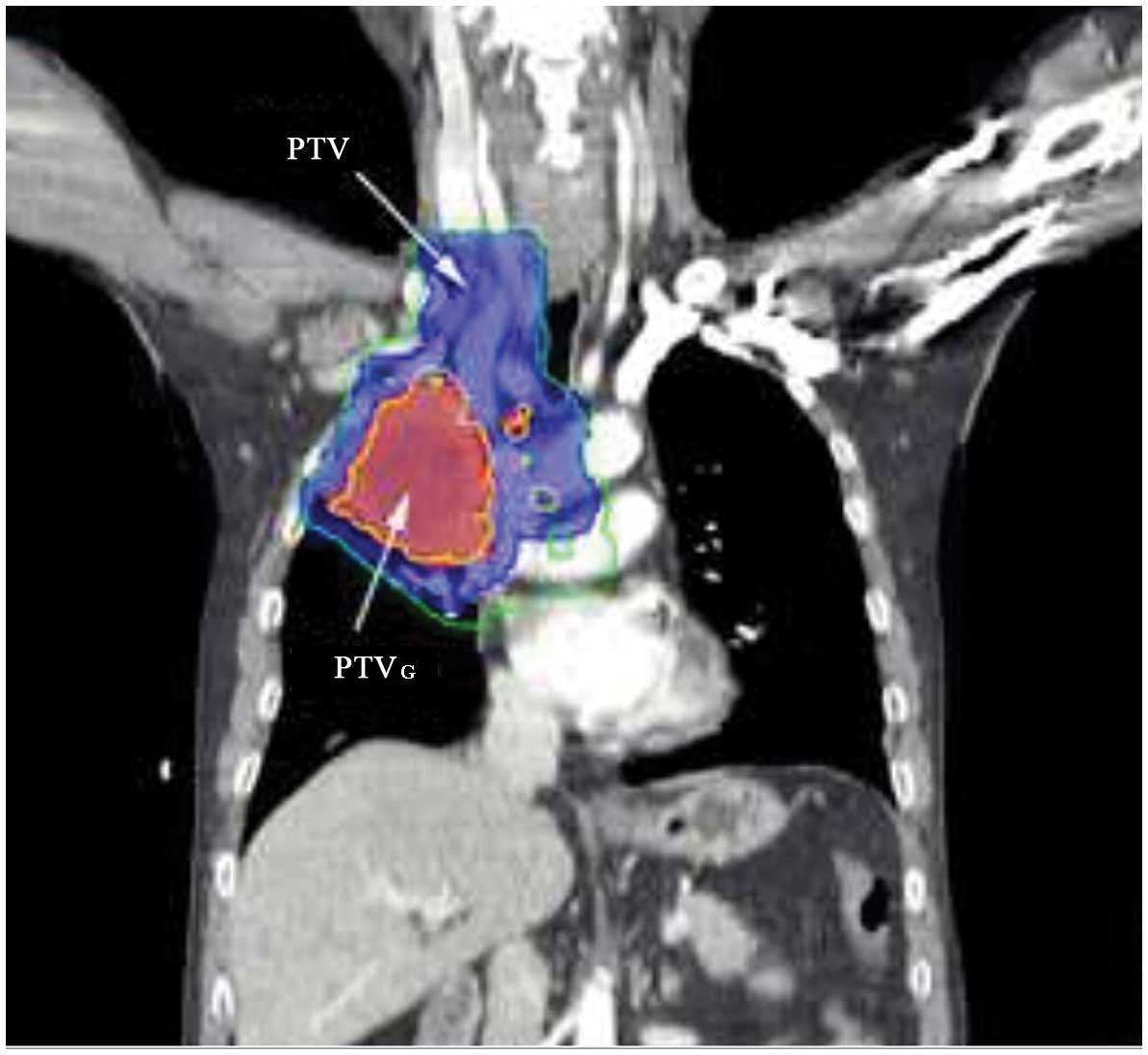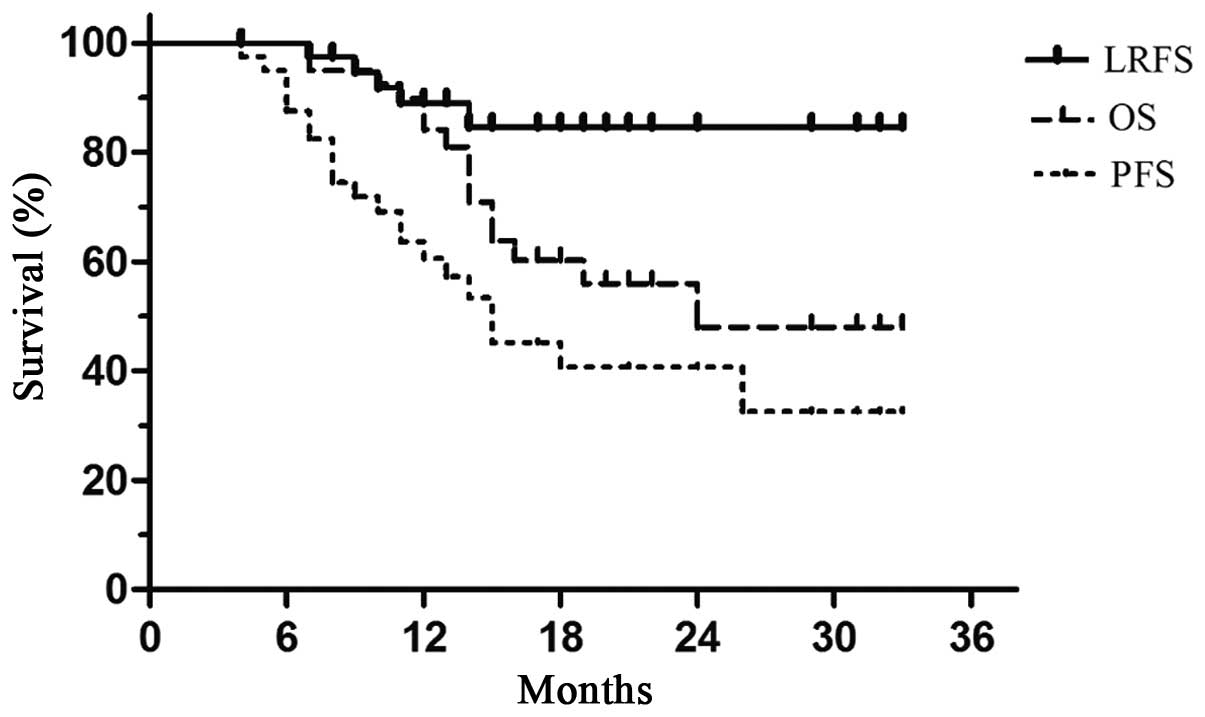|
1
|
Takada M, Fukuoka M, Kawahara M, Sugiura
T, Yokoyama A, Yokota S, Nishiwaki Y, Watanabe K, Noda K, Tamura T,
et al: Phase III study of concurrent versus sequential thoracic
radiotherapy in combination with cisplatin and etoposide for
limited-stage small-cell lung cancer: Results of the Japan Clinical
Oncology Group Study 9104. J Clin Oncol. 20:3054–3060. 2002.
View Article : Google Scholar : PubMed/NCBI
|
|
2
|
Turrisi AR III, Kim K, Blum R, Sause WT,
Livingston RB, Komaki R, Wagner H, Aisner S and Johnson DH:
Twice-daily compared with once-daily thoracic radiotherapy in
limited small-cell lung cancer treated concurrently with cisplatin
and etoposide. N Engl J Med. 340:265–271. 1999. View Article : Google Scholar : PubMed/NCBI
|
|
3
|
Hann CL and Rudin CM: Management of
small-cell lung cancer: Incremental changes but hope for the
future. Oncology (Williston Park). 22:1486–1492. 2008.PubMed/NCBI
|
|
4
|
Aridgides PD, Movsas B and Bogart JA:
Thoracic radiotherapy for limited stage small cell lung carcinoma.
Curr Probl Cancer. 36:88–105. 2012. View Article : Google Scholar : PubMed/NCBI
|
|
5
|
Komaki R, Swann RS, Ettinger DS, Glisson
BS, Sandler AB, Movsas B, Suh J and Byhardt RW: Phase I study of
thoracic radiation dose escalation with concurrent chemotherapy for
patients with limited small-cell lung cancer: Report of Radiation
Therapy Oncology Group (RTOG) protocol 97-12. Int J Radiat Oncol
Biol Phys. 62:342–350. 2005. View Article : Google Scholar : PubMed/NCBI
|
|
6
|
Schild SE, Bonner JA, Hillman S, Kozelsky
TF, Vigliotti AP, Marks RS, Graham DL, Soori GS, Kugler JW, Tenglin
RC, et al: Results of a phase II study of high-dose thoracic
radiation therapy with concurrent cisplatin and etoposide in
limited-stage small-cell lung cancer (NCCTG 95-20-53). J Clin
Oncol. 25:3124–3129. 2007. View Article : Google Scholar : PubMed/NCBI
|
|
7
|
Schild SE, Bonner JA, Shanahan TG, Brooks
BJ, Marks RS, Geyer SM, Hillman SL, Farr GH Jr, Tazelaar HD, Krook
JE, et al: Long-term results of a phase III trial comparing
once-daily radiotherapy with twice-daily radiotherapy in
limited-stage small-cell lung cancer. Int J Radiat Oncol Biol Phys.
59:943–951. 2004. View Article : Google Scholar : PubMed/NCBI
|
|
8
|
Bradley J, Masters G, Hu C, Blumenschein
G, Bogart J, Schild S, Michalski JM, Kavadi V, Garces YI, Narayan
S, et al: An intergroup randomized phase III comparison of
standard-dose (60 Gy) vs high-dose (74 Gy) chemoradiotherapy (CRT)
+/- cetuximab (cetux) for stage III non-small cell lung cancer
(NSCLC): Results on cetux from RTOG 0617. Clin Adv Hematol Oncol.
12:2–4. 2014.
|
|
9
|
Studer G, Peponi E, Kloeck S, Dossenbach
T, Huber G and Glanzmann C: Surviving hypopharynx-larynx carcinoma
in the era of IMRT. Int J Radiat Oncol Biol Phys. 77:1391–1396.
2010. View Article : Google Scholar : PubMed/NCBI
|
|
10
|
McCammon R, Rusthoven KE, Kavanagh B,
Newell S, Newman F and Raben D: Toxicity assessment of pelvic
intensity-modulated radiotherapy with hypofractionated simultaneous
integrated boost to prostate for intermediate- and high-risk
prostate cancer. Int J Radiat Oncol Biol Phys. 75:413–420. 2009.
View Article : Google Scholar : PubMed/NCBI
|
|
11
|
Groome PA, Bolejack V, Crowley JJ, Kennedy
C, Krasnik M, Sobin LH and Goldstraw P: Cancer Research and
Biostatistics; Observers to the Committee; Participating
Institutions: The IASLC lung cancer staging project: Validation of
the proposals for revision of the T, N and M descriptors and
consequent stage groupings in the forthcoming (seventh) edition of
the TNM classification of malignant tumours. J Thorac Oncol.
2:694–705. 2007. View Article : Google Scholar : PubMed/NCBI
|
|
12
|
Rusch VW, Asamura H, Watanabe H, Giroux
DJ, Rami-Porta R and Goldstraw P: The IASLC lung cancer staging
project: A proposal for a new international lymph node map in the
forthcoming seventh edition of the TNM classification for lung
cancer. J Thorac Oncol. 4:568–577. 2009. View Article : Google Scholar : PubMed/NCBI
|
|
13
|
Trotti A, Colevas AD, Setser A, Rusch V,
Jaques D, Budach V, Langer C, Murphy B, Cumberlin R, Coleman CN and
Rubin P: CTCAE v3.0: Development of a comprehensive grading system
for the adverse effects of cancer treatment. Semin Radiat Oncol.
13:176–181. 2003. View Article : Google Scholar : PubMed/NCBI
|
|
14
|
Therasse P, Arbuck SG, Eisenhauer EA,
Wanders J, Kaplan RS, Rubinstein L, Verweij J, Van Glabbeke M, van
Oosterom AT, Christian MC and Gwyther SG: New guidelines to
evaluate the response to treatment in solid tumors. European
Organization for Research and Treatment of cancer, National Cancer
Institute of the United States, National Cancer Institute of
Canada. J Natl Cancer Inst. 92:205–216. 2000. View Article : Google Scholar : PubMed/NCBI
|
|
15
|
Kalemkerian GP, Akerley W, Bogner P,
Borghaei H, Chow LQ, Downey RJ, Gandhi L, Ganti AK, Govindan R,
Grecula JC, et al: Small cell lung cancer. J Natl Compr Canc Netw.
1:78–98. 2013.
|
|
16
|
Bradley J, Graham MV, Winter K, Purdy JA,
Komaki R, Roa WH, Ryu JK, Bosch W and Emami B: Toxicity and outcome
results of RTOG 9311: A phase I–II dose-escalation study using
three-dimensional conformal radiotherapy in patients with
inoperable non-small-cell lung carcinoma. Int J Radiat Oncol Biol
Phys. 61:318–328. 2005. View Article : Google Scholar : PubMed/NCBI
|
|
17
|
Sulman EP, Komaki R, Klopp AH, Cox JD and
Chang JY: Exclusion of elective nodal irradiation is associated
with minimal elective nodal failure in non-small cell lung cancer.
Radiat Oncol. 4:52009. View Article : Google Scholar : PubMed/NCBI
|
|
18
|
Kimura T, Togami T, Nishiyama Y, Ohkawa M
and Takashima H: Impact of incidental irradiation on clinically
uninvolved nodal regions in patients with advanced non-small-cell
lung cancer treated with involved-field radiation therapy: Does
incidental irradiation contribute to the low incidence of elective
nodal failure? Int J Radiat Oncol Biol Phys. 77:337–343. 2010.
View Article : Google Scholar : PubMed/NCBI
|
|
19
|
Choi NC, Herndon JN II, Rosenman J, Carey
RW, Chung CT, Bernard S, Leone L, Seagren S and Green M: Phase I
study to determine the maximum-tolerated dose of radiation in
standard daily and hyperfractionated-accelerated twice-daily
radiation schedules with concurrent chemotherapy for limited-stage
small-cell lung cancer. J Clin Oncol. 16:3528–3536. 1998.PubMed/NCBI
|
|
20
|
Jiang ZQ, Yang K, Komaki R, Wei X, Tucker
SL, Zhuang Y, Martel MK, Vedam S, Balter P, Zhu G, et al: Long-term
clinical outcome of intensity-modulated radiotherapy for inoperable
non-small cell lung cancer: The MD Anderson experience. Int J
Radiat Oncol Biol Phys. 83:332–339. 2012. View Article : Google Scholar : PubMed/NCBI
|
|
21
|
Liu HH, Wang X, Dong L, Wu Q, Liao Z,
Stevens CW, Guerrero TM, Komaki R, Cox JD and Mohan R: Feasibility
of sparing lung and other thoracic structures with
intensity-modulated radiotherapy for non-small-cell lung cancer.
Int J Radiat Oncol Biol Phys. 58:1268–1279. 2004. View Article : Google Scholar : PubMed/NCBI
|
|
22
|
Shirvani SM, Komaki R, Heymach JV,
Fossella FV and Chang JY: Positron emission tomography/computed
tomography-guided intensity-modulated radiotherapy for
limited-stage small-cell lung cancer. Int J Radiat Oncol Biol Phys.
82:e91–e97. 2012. View Article : Google Scholar : PubMed/NCBI
|
|
23
|
Palma DA, Senan S, Tsujino K, Barriger RB,
Rengan R, Moreno M, Bradley JD, Kim TH, Ramella S, Marks LB, et al:
Predicting radiation pneumonitis after chemoradiation therapy for
lung cancer: An international individual patient data
meta-analysis. Int J Radiat Oncol Biol Phys. 85:444–450. 2013.
View Article : Google Scholar : PubMed/NCBI
|
















